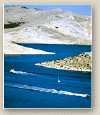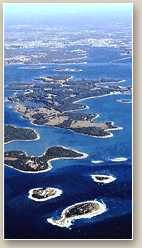|
site
map |
|
|
|
CROATIAN ADRIATIC NAME - ancient Greek geographers
named it for the city of Adria on the mouth of the river Po
The Adriatic Sea is a bay of the Mediterranean Sea, separated by the Apennine Peninsula. It penetrates farthest into the European continent, giving it a great economic importance. Croatia occupies approximately half of the mainland coast (48%) and 97% of the island coastline. The Croatian coast can be divided into Istria, Croatian Primorje and Kvarner. The north of the island of Pag, and Dalmatia, which is south or the island of Pag. The name of Dalmatia originated in Roman times when the Emperor August divided the province of Illyric into provinces Dalmatia and Panonia. The northwestern Adriatic is shallow with a floor of sand and silt and depths generally under 100 meters. The southeastern Adriatic is much deaper and makes up more than 90% of total volume. The largest island is Krk, known to its inhabitants as “the seventh continent,” and the largest peninsulas are Istria and Pelješac. The largest bay is the Gulf of Kvarner (many bays, channels and passages). The largest river that flows into the eastern Adriatic is the Neretva, and other Croatian rivers that empty into the Adriatic are the Mirna and Raša in Istria, and the Zrmanja, Krka and Cetina in Dalmatia. RELIEF AND NATURE
The Croatian coast is not attractive only because of its indentation, but also because of the uniqueness of the relief: the steep, karstic mountain ranges of Učka, Velebit, Dinara, Svilaja, Kozjak, Mosor and Biokovo rise above the green of the coast like a magnificent façade. Velebit, the highest and largest of them, spreads for 120 kilometres along the sea. That fantastic mountain, “the pride of the Croatian people,” causes both awe, because of its cruelty, and excitement, because of the diversity of natural beauty. CLIMATE Because of very gentle and healthy climate, the Croatian coast is very siutable for living and for holidays. Its narrow coastal area and islands have a Mediterranean climate (gentle and rainy winters and warm, dry summers), while inland the dominant climate is Sub-Mediterranean (colder winters and hotter summers). In January, north from Šibenik, the averege temperature is between 4°- 6°C, while south from Šibenik it is warmer. In July, the average air temperature on the Croatian coast is between 22.8° and 25.9°C. WINDS The most usual winds are bura, jugo and maestral. Bura is a specific coastal north-eastern wind: it is more frequent in winter than in summer and blows in gusts, sometimes over 120 km per hour. It raises waves to 2.5 m high and brings mostly clear weather. The bura of Senj is especially known as wild and strong. Jugo is the warm and humid south-eastern wind that blows at a constant speed, raising relatively high waves. The people are especially fond of maestral, the daily landward breeze that blows off the sea in the warmer part of the year and makes summer heat easier to endure. SEA CURRENT As throughout the Mediterranean Sea, the current is relatively weak, with weaker current along the Croatian coast, due to the numerous islands, than on the Italian coast. The sea currents have no significant influence on navigation on the Adriatic Sea. The tide oscillations are also small and they vary from the south (15-20 cm). VEGETATION Gentle winters, dry and hot summers caused growth of the exuberant Mediterranean evergreen vegetation of the coast: slender cypresses, aromatic laurels, blooming oleanders, graceful tamarisks, strange aloes and flowering agaves, magnificent sunny-yellow mimosas, mellow oranges, tangerines and lemons, almonds, fragrant pines: and the symbol of the coast- the olive tree and the wondrous fig tree. The most significant vegetation type on the coast is modest macchia (dense evergreen underbrush) with its green junipers, whose beauty is complemented with the fragrance of sage, heather and rosemary. THE ANIMAL WORLD The Adriatic has an enchanting diversity of plant and animal species. There are more than 360 species of fish in the Croatian Adriatic. Cephalopods, snails, crabs and shells comprise the rest of the sea fauna. In the depths of the Adriatic, there are beautiful white and red corals that are picked by special craftsmen from the island of Zlarin, while famous sponge collectors live in the Šibenik area. The animal world is completed by the three species of dolphins that live in the Adriatic. For details and you questions please contact as here |
|
|
Real
Estate Nekretnine, Split,
Croatia tel:
+356 79010337 Terms and Conditions | Privacy statement | info@nekretnine.org |


